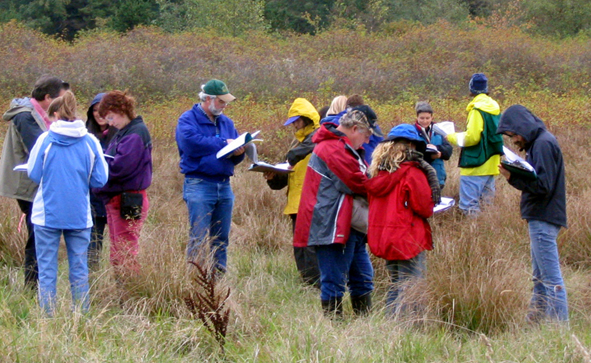
Successful use of wetland identification and assessment tools includes an understanding of different wetland classification systems and how to apply them. This four-day class will introduce participants to four different classification systems used in wetland work, Cowardin, Hydrogeomorphic (HGM), U.S. National Vegetation Classification (USNVC), and Landscape, Land form, Water flow path, Waterbody type (LLWW). Participants will learn about the background and development of the classification systems, how to apply and interpret them at site and landscape levels, and general caveats associated with using different wetland classification systems.
The Cowardin classification system is the framework for wetland polygons in the National Wetland Inventory (NWI) published by U.S. Fish and Wildlife Service. Cowardin and HGM classification systems are used in the Washington Wetland Rating System (2014 Update) to characterize a wetland’s potential for hydrologic, water quality, and habitat functions and ecosystem services. Misclassification results in inaccurate assessments of wetland functions and levels of performance, which can affect mitigation requirements and buffers. In Washington, buffers are established based on an assessment of the wetland’s sensitivity and rarity and the functions it provides. Cowardin and HGM classification are integral components of those assessments.
The USNVC is a hierarchical vegetation classification covering both upland and wetland ecosystems. The Washington Natural Heritage Program (WNHP) uses the finest level of the USNVC (plant associations) to inform conservation targets (e.g., Wetlands of High Conservation Value). WNHP recently modified the USNVC to more explicitly incorporate ecological relationships among plant associations. The resulting classification unit, subgroups, are specific to Washington’s wetlands. Subgroups are used as a basis for conducting Ecological Integrity Assessment (EIA) for wetlands and riparian areas in Washington and provide an alternative scale for mapping and conservation targets. The USNVC is increasingly being used as a vegetation mapping standard for many agencies and organizations such as the National Park Service, U.S GAP, and LANDFIRE.
This course will include four virtual sessions. The virtual sessions will be hosted on Zoom on 12/7/2020 (9:00 AM – 12:00 PM), 12/8/2020 (9:00 AM – 12:00 PM), 12/9/2020 (9:00 AM – 12:00 PM), 12/10/2020 (9:00 AM – 12:00 PM). During the sessions the instructors will provide instruction on different types of wetland classification systems and display videos of different sites and ask the participants to classify the wetland based on the video. (12 CM AICP Credits/CEP Points).
Instructors:
Dr. Amy Yahnke is the senior wetland ecologist for the Shorelands and Environmental Assistance Program at the Washington State Department of Ecology. She holds a Certificate in Wetland Science and Management, BS in Environmental Horticulture, MS in Forest Resources, and PhD in Aquatic and Fishery Sciences. She has studied wetland ecology within the contexts of amphibians, invasive plants, and stormwater management. Dr. Yahnke has experience teaching a wide range of environmental topics to audiences of all ages.
Joe Rocchio is the Program Manager of the Washington Department of Natural Resources, Natural Heritage Program (WNHP). He supports WNHP's staff of two ecologists, botanist, data manager, and information specialist in providing essential data to planners and landowners to assist them in making informed land use decisions that balance economic growth with the conservation of our state’s natural heritage. WNHP also plays an integral role in nominating sites to be included in Washington's statewide system of natural area preserves. Before taking on the Program Manager role, Joe spent 12 years as one of WNHP's ecologists, at which time his primary responsibilities were to maintain a statewide ecosystem classification, develop and implement methods to assess ecological integrity, and identify ecosystem conservation priorities. Joe has worked with most of Washington’s ecosystems, although wetlands (especially peatlands) are his expertise. Since joining WNHP in 2007, a significant portion of his work has focused on classifying Washington wetlands using the U.S. National Vegetation Classification and developing a rapid assessment protocol to assess wetland condition (i.e., Ecological Integrity Assessment). Joe has a B.S. in Environmental Science from Indiana University and M.S. in Ecosystem Analysis from the University of Washington. Joe is a Regional Editor for the U.S. National Vegetation Classification Review Board and the Vice Chair of NatureServe's U.S. Section Council.
